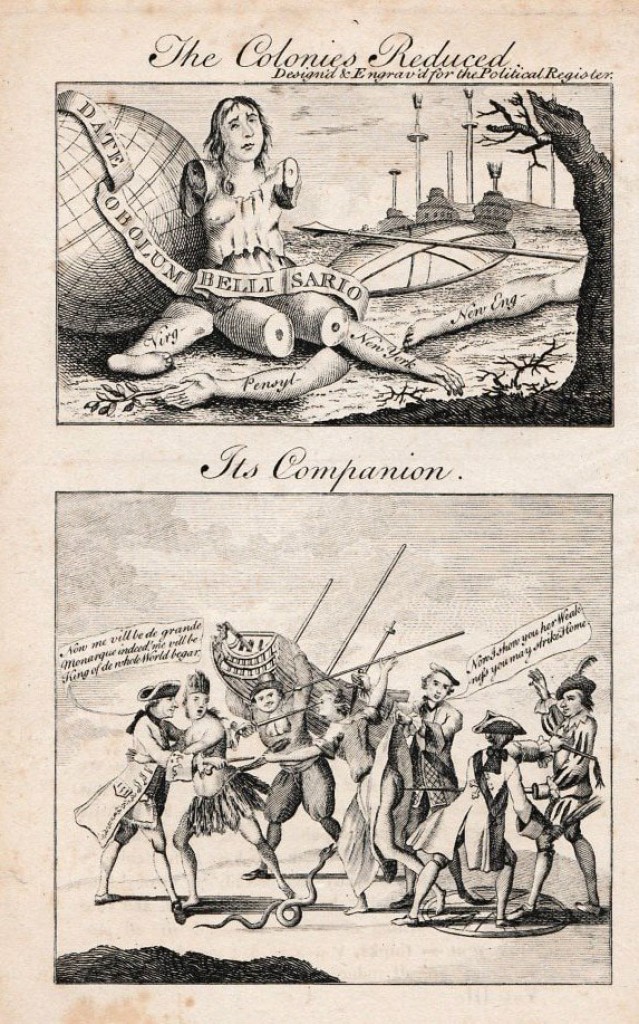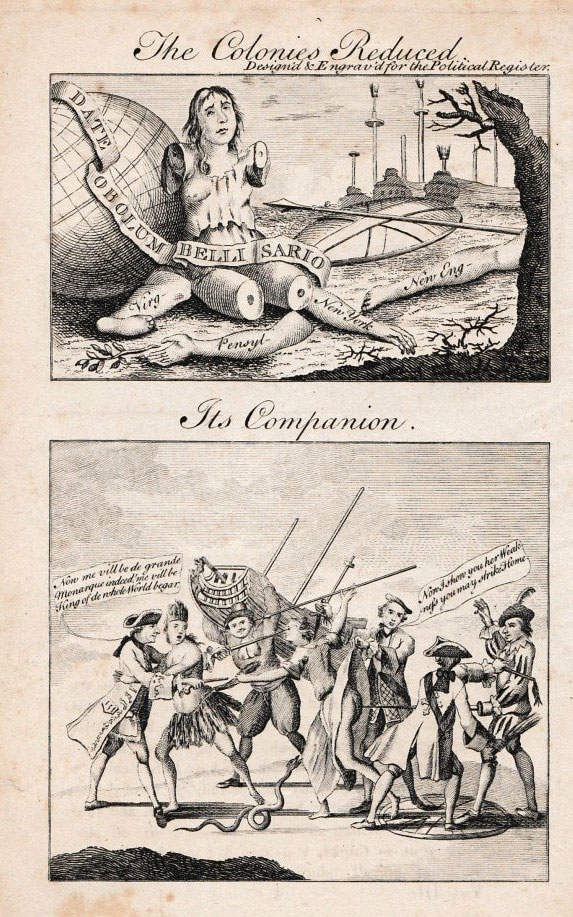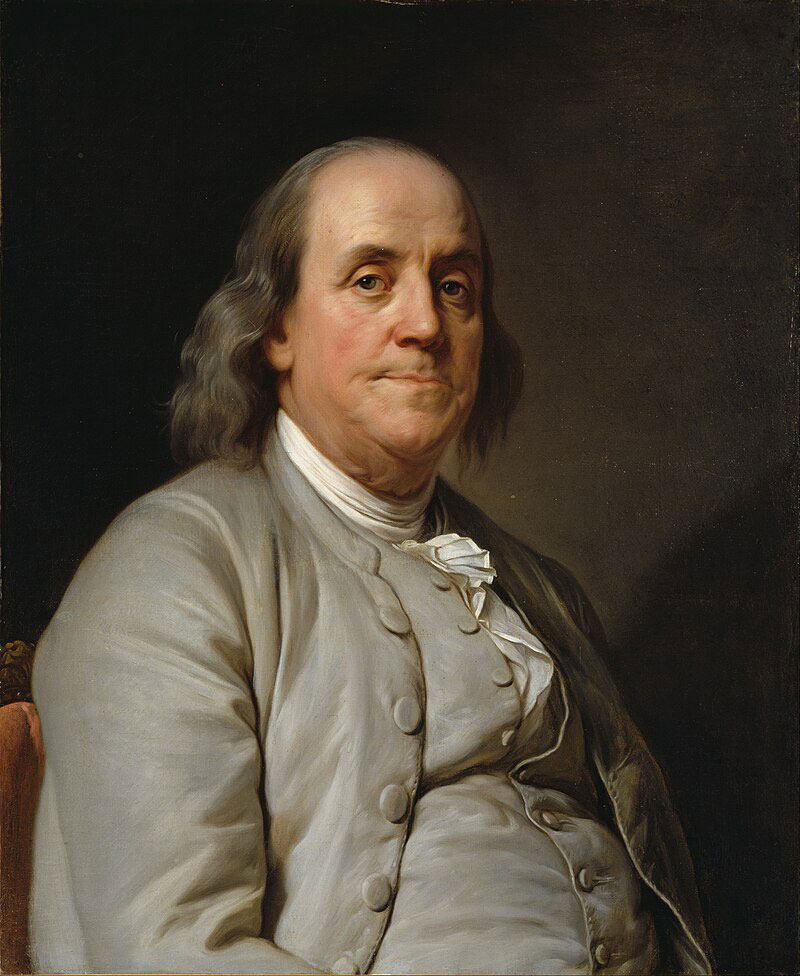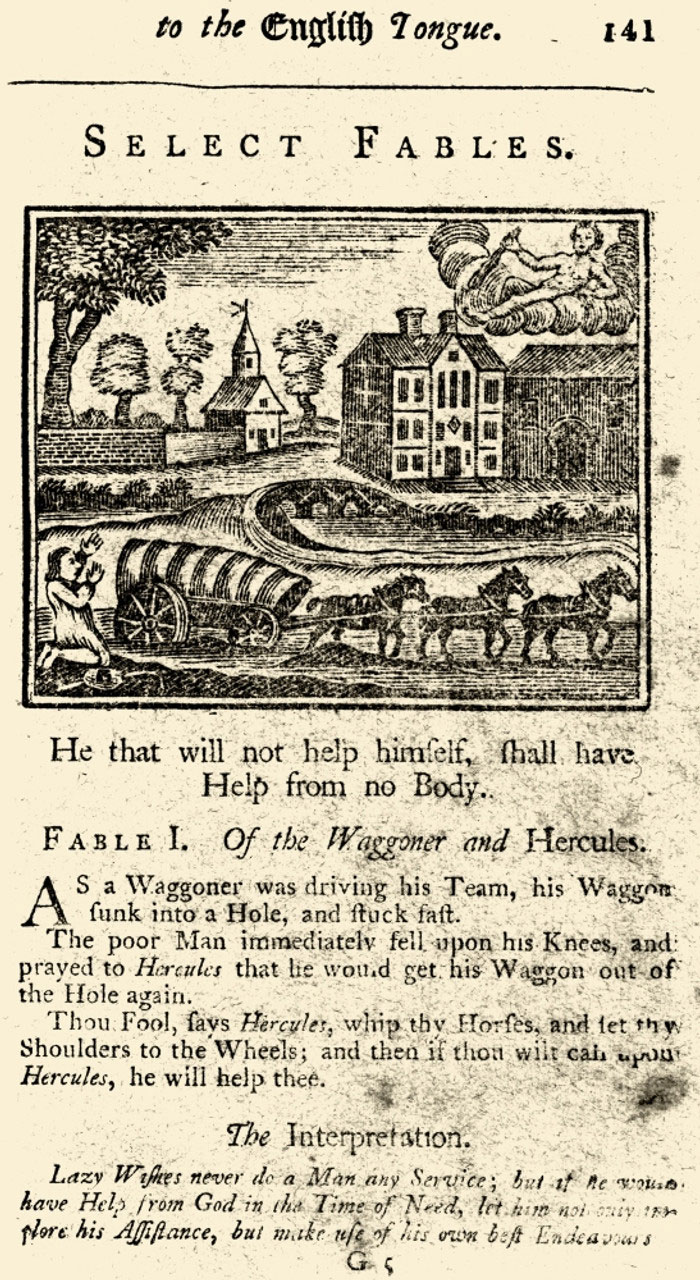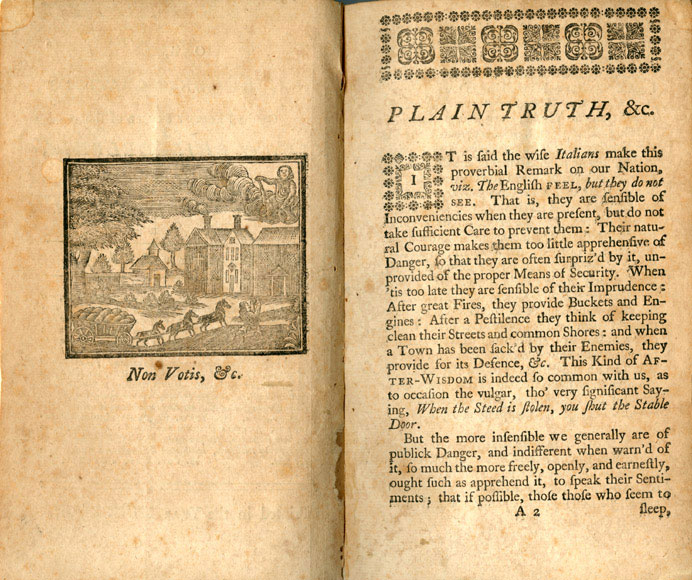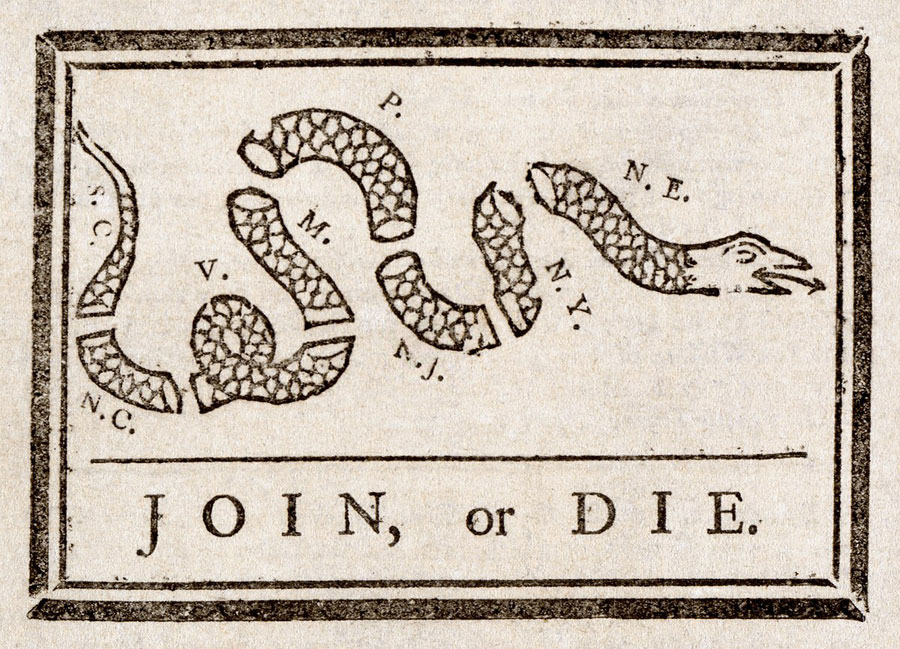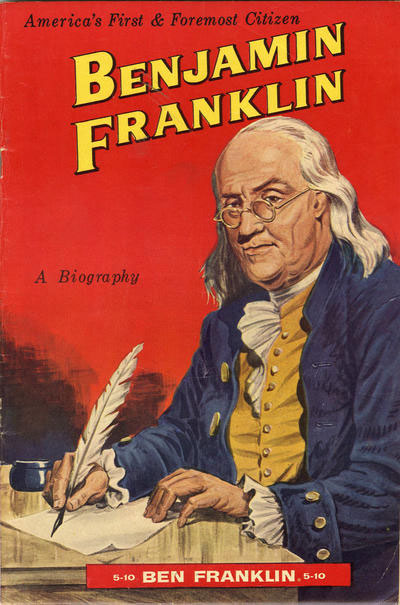'Magna Britannia: The Colonies Reduced/Its Companion' (1766).
Benjamin Franklin was an 18th-century U.S. inventor, scientist, writer, printer, journalist, publisher, diplomat, politician and… cartoonist. He was active in so many different intellectual fields that he can be regarded as the U.S. equivalent of Leonardo da Vinci. Franklin played an instrumental role in the transition of his country into a modern independent nation. Among other things, he set up the University of Pennsylvania, was the first U.S. postmaster general and co-edited the U.S. Constitution. As a scientist, he made history by inventing the lightning rod. Active in the early U.S. newspaper industry, Franklin penned down columns, articles, aphorisms, proverbs and made the earliest known political cartoons created on U.S. soil. His iconic 'Join or Die' (1754) is widely regarded as the starting point of his country's rich history of cartooning. But Franklin also created a sequential cartoon with prototypical speech balloons, 'Magna Britannia: The Colonies Reduced/Its Companion' (1766), which makes him the earliest prototypical comic artist on U.S. soil whom historians can credit by name.
Early life and work
Benjamin Franklin was born in 1706 in Boston, Massachusetts, as the son of a soap and candle maker. Lack of money in the Franklin household forced him to drop out of school at age 10 and work in his father's store. Soon Franklin got a job as an apprentice in his brother's printing studio, learning the odds and ends of newspaper manufacturing. Under various pseudonyms, he also wrote readers' letters for his brother's paper, The New-England Courant. When his brother was jailed in 1722 for insulting governor Samuel Shute in one of his articles, Franklin ran the paper on his own for a while, pleading for freedom of speech. At age 17, he eventually ran away from home, spending a few years in London working as a typesetter. Back in Boston, he worked in a bookstore for a while, until the owner died.
In 1728, Franklin and Hugh Meredith established The Pennsylvania Gazette and Die Philadelphische Zeitung, the first German-language newspaper in the USA. He established a reputation as a witty and insightful writer, educating his readers through essays, columns and editorials, while simultaneously setting up a newspaper network circulating in all 13 British colonies in North America. In 1731, Franklin founded the Library Company of Philadelphia and a year later an annual almanac, Poor Richard's Almanack. Many of the proverbs, sayings and aphorisms printed in this almanac have found their way into the regular language, including "time is money", "eat to live and not live to eat" and "early to bed and early to rise, makes a man, healthy, wealthy and wise." However, it should be noted that some quotes were already well-known before Franklin wrote them down. He expressed his creativity in different artforms too, playing violin, harp, guitar and improving the glass harmonica.
Benjamin Franklin, portrait by Joseph Duplessis (1785).
Political endeavors
In 1747, Benjamin Franklin left his printing firm in the hands of his business partner David Hall, though still collected part of the earnings. It gave him financial stability and the ability to focus on his countless other interests. Franklin improved the state of Pennsylvania by introducing many significant innovations, like a volunteer fire brigade (1736), a philosophical society (1743), a hospital (1751), homeowner insurance (1752) and a university (1755). He became the first postmaster general (1753), reforming the U.S. postal system. Franklin also went into politics, rising to councilman (1748), justice of the peace (1749) and speaker of the house (1764). As a representative of the Pennsylvania Assembly, he stayed in London for longer periods of time (1757-1762, 1764-1774), giving him a clear understanding of the two countries' different societies. Franklin served as a diplomat, trying to find common ground between the British Parliament and the increasingly dissatisfied American population living under colonial rule. By the late 1760s, Franklin also favored independence. When the U.S. War of Independence broke out, he secured necessary funding from French king Louis XVI, while using his newspaper network to spread propaganda against the British. In 1776, the United States became the first colony in the world to gain independence. Thomas Jefferson wrote a new constitution, which Franklin gave a final revision. When the document was presented in Congress, Franklin was the oldest person to place his signature underneath the text.
Science and eccentricities
Internationally, Franklin achieved additional fame in the field of science. He invented the Franklin stove (1742), lightning rod (1752), bifocal glasses and the flexible urinary catheter. He was a visionary man, being an early promoter of vaccination, vegetarianism, freedom of speech and religious tolerance. While he owned slaves early in life, he later set them free and became a staunch opponent of slavery. In his essay 'The Speech of Miss Polly Baker' (1747), Franklin pointed out the hypocrisy of putting women on trial for having illegitimate children, when the fathers remained free from legal persecution. He had first-hand knowledge of such issues, being a notorious womanizer with one illegitimate son.
Like many geniuses, Franklin also has his eccentricities. He enjoyed letting cold air in during the mornings, while taking a bath or simply sitting in his room, writing or reading in the nude. While a witty satirist, he wasn't below toilet humor either. His satirical text 'Advice to a Friend on Choosing a Mistress' (1745), describes why older women are more interesting than younger ones and goes into explicit sexual detail. His 'A Letter to Royal Academy' (1781) starts off as a prestigious essay, but ends in praise of farting. Both texts were censored for a while in the more prudent decades that followed.
Cartooning career
While Franklin was predominantly a journalist, editor and columnist, he also made another significant contribution to the U.S. press industry: cartooning. In 1746, Franklin distributed a pamphlet, 'Plain Trouble' (1746), depicting an illustration of the Fable of the Waggoner and Hercules. A year later, he designed the flag for the Pennsylvania Associators, depicting a lion with a sword and a shield, shaped like Pennsylvania. The same year, on 17 November, he also published an illustrated pamphlet titled 'Plain Truth: or, Serious Considerations on the Present State of the City of Philadelphia, and Province of Pennsylvania', advocating military defense against recent threats from French privateers endangering the American coastal waters.
In May 1754, Franklin drew what is widely considered the first political cartoon made on U.S. soil: 'Join, or Die'. The image, printed in the Pennsylvania Gazette, depicts a chopped up rattlesnake, symbolizing the 13 British colonies on the North American East Coast. The drawing implies that this metaphorical snake should unite as one nation. It is often thought that 'Join, or Die' was an original creation, but in a 1685 French book, a similar chopped up snake appeared in an engraving with the exact same message: "Se Rejoindre ou Mourir" ("Rejoin or Die"). Another misconception about 'Join or Die' is that Franklin drew the cartoon in favor of the U.S. independence movement to rise against English colonial rule. However, in its original context, 'Join, or Die' was actually a reaction against the French and Indian War (1754-1763), when the British colonies in North America fought against the French. The cartoon therefore rallied U.S. citizens to unite behind the British against the French. Once the British defeated the French and continued their colonial rule, more local Americans favored an uprising and reused 'Join, or Die' to support their cause. The cartoon was reprinted in The Constitutional Courant as a propaganda tool.
'Plain Truth: or, Serious Considerations on the Present State of the City of Philadelphia, and Province of Pennsylvania'.
Originally, Franklin was in favor of societal change in his home country, but not a straight-out rebellion. He did oppose the Stamp Act (1765), an official colonial tax on legal documents, including newspapers. In a direct reaction, Franklin drew a two-panel cartoon, 'Magna Britannia: her Colonies Reduced… Her Companion" (1766). The first panel, 'Magna Britannia: Her Colonies Reduced', depicts the British national personification Lady Britannia as a limbless figure. Her arms and legs (with the names of the colonies written on them) are scattered on the ground, next to a chopped off British oak and olive branch fallen from the hand of Pennsylvania. The ribbon across her body reads "Date Obolum Bellisario" ("Give A Penny to Belisarius"), referencing the famous Roman general Belisarius who also fell from grace. In the background are anchored ships, with brooms at their mastheads, implying they are for sale. In the second panel, 'Her Companion', Britannia is further stabbed by France and Spain, while The Netherlands carries off with one of her ships. The United States, depicted as a Native American, rejoices in the arms of the French king.
'Magna Britannia: her Colonies Reduced… Her Companion' implied that if the British government didn't listen to its people in the 13 colonies, it might lead to a rebellion, toppling the British Empire. Franklin printed the cartoon on cards and distributed it among members of Parliament. One version was printed in The Political Register of December 1768. By that date, the Stamp Act had already been repealed due to many protests. 'Magna Britannia: her Colonies Reduced… Her Companion' is notable as the first known sequential cartoon, picture story and prototypical comic made by an artist on U.S. soil (though still a decade before the United States effectively became an independent state). It also marked the first use of prototypical speech balloons in a U.S. picture story. Franklin, who was in England at the time of the cartoon's publication, was probably familiar with the developing British caricaturing industry. In 1956, editor Wilmarth S. Lewis discovered two anonymous English cartoons predating Franklin's, expressing similar metaphors, 'Britannia Dismembered and Disemboweled' (1749) and 'The English Lion Dismember'd' (1756). On both, the British national symbols Lady Britannia and the British Lion are literally subdivided by foreign forces. Still, Franklin's version is a widely different picture story in terms of imagery. As the U.S. Independence Movement grew, Franklin's cartoons, especially 'Join or Die', were endlessly reprinted. The metaphorical snake in the cartoon effectively became the national personification of the United States for a while and was copied by British cartoonists like James Gillray (for instance in his cartoon 'The American Rattle Snake', 1782).
While the 1747 flag, 'Join or Die' and 'Magna Britannia' were certainly designed by Franklin, there is no absolute proof that he actually drew them firsthand. It is possible that an anonymous assistant worked out his sketches. Either way, they have always been attributed to him and he certainly bore graphic responsibility, since the works appeared under his name. As Franklin's cartoons were used in anti-English propaganda, the opposite was true too. In the 1760s, several anonymous cartoons were distributed criticizing Franklin and his stance "against" the colonial state. In some he was demonized as an incarnation of The Devil. One of these anti-Franklin cartoonists who has been identified was James Claypoole. When the United States seceded from the United Kingdom in 1776, Franklin's cartoons were seen in a new light and his reputation improved again. Historians regard him as the starting point of the U.S. cartooning industry, paving the way for other late 18th-century, early 19th-century U.S. cartoonists like James Akin, William Charles, James Claypoole, Amos Doolittle, Edward Williams Clay, David Claypool Johnston, John L. Magee and Henry Robinson.
Death, legacy and influence
A corpulent man, Franklin was plagued by gout in old age. In 1790, he died at age 84. His funeral was attended by over 20,000 people. Along with George Washington, Thomas Jefferson and James Madison, he was quickly elevated to the honorary title of "Founding Father" and kept in memory in various U.S. nationalist works and historical fiction. His face adorns the 100 dollar bill, and various schools, towns, memorials and monuments have been named after him. As the first postmaster of his country, he was naturally featured on many stamps too.
Benjamin Franklin inspired many novels, plays, films, TV shows and comics. In 1939, Robert Lawson wrote and illustrated the children's novel 'Ben and Me', about a tiny mouse, Amos, who befriends Benjamin Franklin and participates with many of the events that made Franklin famous. In 1953, the Walt Disney Company adapted and condensed 'Ben and Me' into a 21-minute animated short. Amos the mouse shares a design with Gus from Disney's other film 'Cinderella' (1950), while Franklin is basically Smee from Disney's 'Peter Pan', also released in 1953. In March 1954, Disney's version of 'Ben and Me' was also adapted into comic story, printed by Dell Comics as issue #539 in their Four Color series. The script was provided by Del Connell, with artwork by Al Hubbard.
In the 1920s, Herb Roth illustrated a reprint of Benjamin Franklin's 'On the Choice of a Mistress and Other Satires and Hoaxes'. When Stan Lee and Steve Ditko looked for a suitable name for Spider-Man's uncle in 'Spider-Man' (1962) they named him "Uncle Ben" after Franklin. That same year, comic writer Frank Jacobs launched 'Alfred's Poor Almanack', an often recurring feature in Mad Magazine, spoofing Benjamin Franklin's 'Poor Richard’s Almanack'. Disney comic artist Adolfo Urtiága also made a comic book loosely based on Franklin's life, starring Goofy. As issue #65 of its first series of 'Classics Illustrated', publisher Gilberton released a comic adaptation of Benjamin Franklin's autobiography (1949), created by Robert Hebberd, Gus Schrotter and Alex Blum.
1956 reprint of Classics Illustrated #65.


